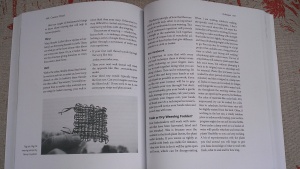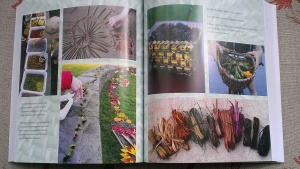Some time ago, I discovered the wonderful blog of artist Sharon Kallis. I think it was one of those moments of serendipity that the world wide web enables so marvellously–she stopped by this blog having found a post about processing nettle fibre (unsuccessfully, I might add) and left a trace of some sort–like a kind comment–and I wondered what she was writing about and went to find out.
Her blog is a trove of inspiring writing and action. She is part of a multitude of projects I find really exciting–when I first found her blog, she was using basketry techniques with weedy species to control erosion, raise consciousness about weeds, and build community. Since then, she has been involved in community gardening projects, including communally growing and processing flax to make linen. She has been working with parks using what would otherwise be waste vegetation or prunings for basketry, dyeing, sculpture and other community projects. She is spreading awareness about bees and building bee habitats in the suburbs. And so on. Many of these projects have educational, celebratory, musical and film aspects that make them all the richer and more exciting.
Imagine my delight when I realised that she was writing a book! I pre-ordered Common Threads (New Society Publishers, 2014) and was so utterly delighted by it I remember wondering if it was possible I could quit my life-eating (though in many respects wonderful) day job and take up community art instead. Somehow months have passed without my writing a review. But here it is at last. The book is rich in sources of inspiration, full of ideas, imagination, interviews with other community and eco-artists whose work inspires and informs. It is divided into three sections: Places, People and Plants.
In Places, Sharon writes about the imperative to use what is local, including what is invasive and weedy in a local landscape. In relation to weeds, her approach centres on problem solving from the troublesome features of invasive species toward using them as resources for sustainability. The projects featured engage members of the community in learning about invasive species as well as learning basketry and stitching techniques to work with plants. She writes about building change with other members of the community, introducing the concept of ‘backsourcing’: ‘the process of re-claiming what we outsourced when factories took over the production of goods to satisfy the general needs of a developed country’s population.’ Her case studies include the Means of Production Garden, a community garden in which artists grow the plants needed for their art practices; and the Aberthau project in which people grew their own flax in community gardens and household plots and then learned to process it into fibre, thread and eventually, garments.
The People section deals with strategies and processes for building community through engagement with the plant world and the process of growing, harvesting, making and celebrating the seasons.
The final section on Plants provides a wealth of practical information for working with invasive species (many are recognisable in Australia even though Sharon is working in Canada). It then moves on to techniques for basic basketry, netting and string making. The basics of plant dyeing are covered, and the section concludes with the logistics of managing green waste as a source for community projects, accessing funding and partnering with public parks. I am in awe of the reach of this book–all the way from how to turn leaves into string through to how to organise large scale projects utilising the green waste from parks and managing relationships between artists and community workers and public sector authorities.
Each section of the book includes interviews with other artists involved in organising the featured community art projects. I loved these insights into the how and why of these projects. I have my own sense of why these projects might be valuable and interesting, but inevitably other people’s sense of the importance of the local, the environment, and making are diverse and wonderful. I found lots of resonance with ideas and processes that I use in my own small way—but such a profound sense of building community and of building up strategies for change and engagement made vivid and visible.
As the chapters unfold, a critique of consumption and materialism builds up. A sense of the value of all that is impermanent and biodegradable in the face of a society that is structured to require and encourage consumption and which creates disposable packaging that can last for centuries develops. And a sense of what might be done to address these questions opens up.




This book looks wonderful, I am going to try to get hold of a copy, 🙂
LikeLike
I can only recommend it highly!
LikeLike
Lovely way to start my day, thinking about ‘backsourcing’ and ‘valuing the impermanent’, as a way of tending to relationships, building connections and mobilising communities for change. Great review!
LikeLike
You have a way of summing something up that is beyond compare, Manja! Hoping the rest of the day was wonderful… warmly, m
LikeLike
Thanks for sharing this. It touches on so many things that are of interest to me and its nice to see someone out there who has brought it all together in a book. That’s what got me interested in your blog was the working with nature in your dying process which is amazing to follow and see : )
LikeLike
I hope you can access the book, it is just glorious, and it sounds like it would eb a great fit with your interests. Thanks for your kind comment!
LikeLike
I just bought a copy for myself!
LikeLike
I hope you enjoy it as much as I did!
LikeLike